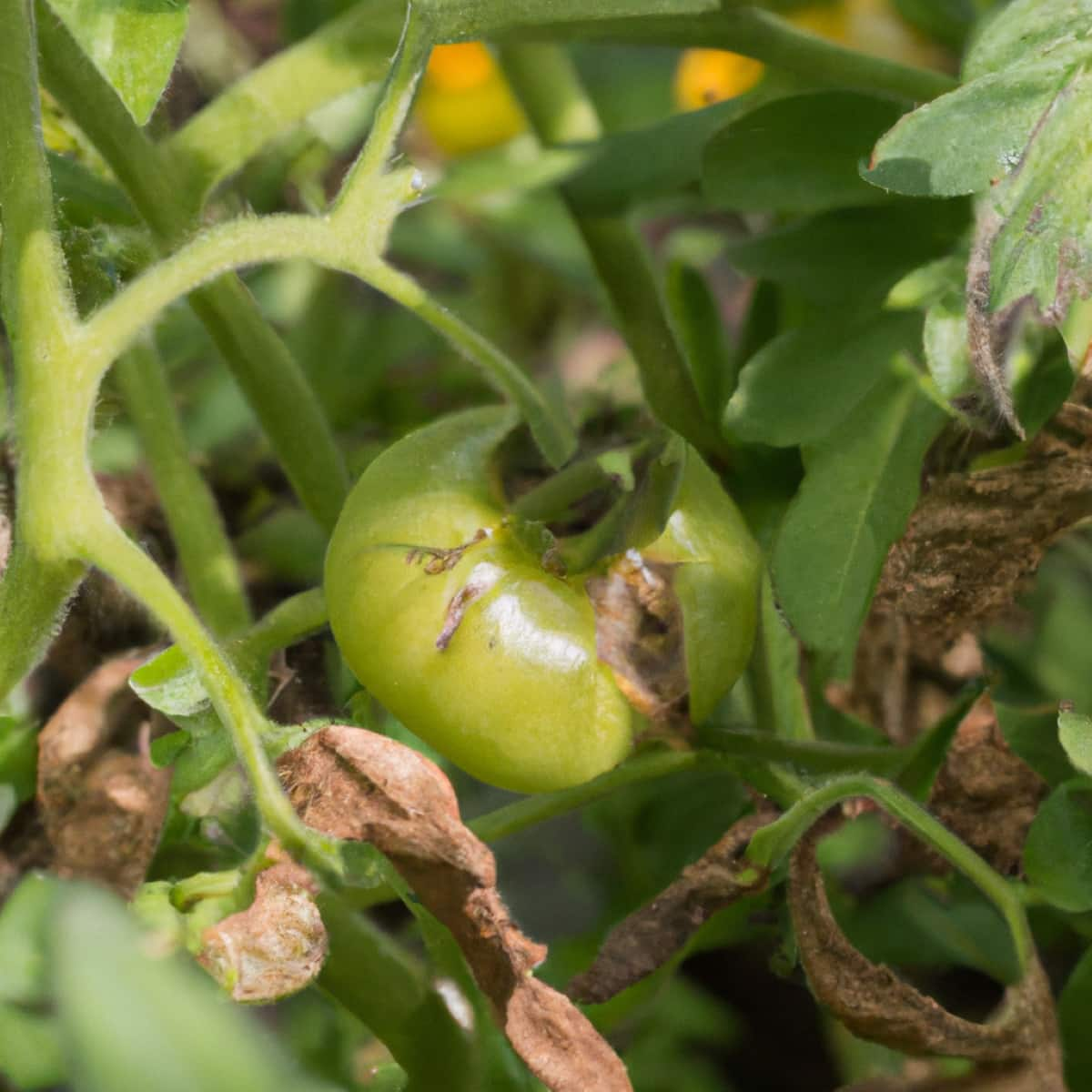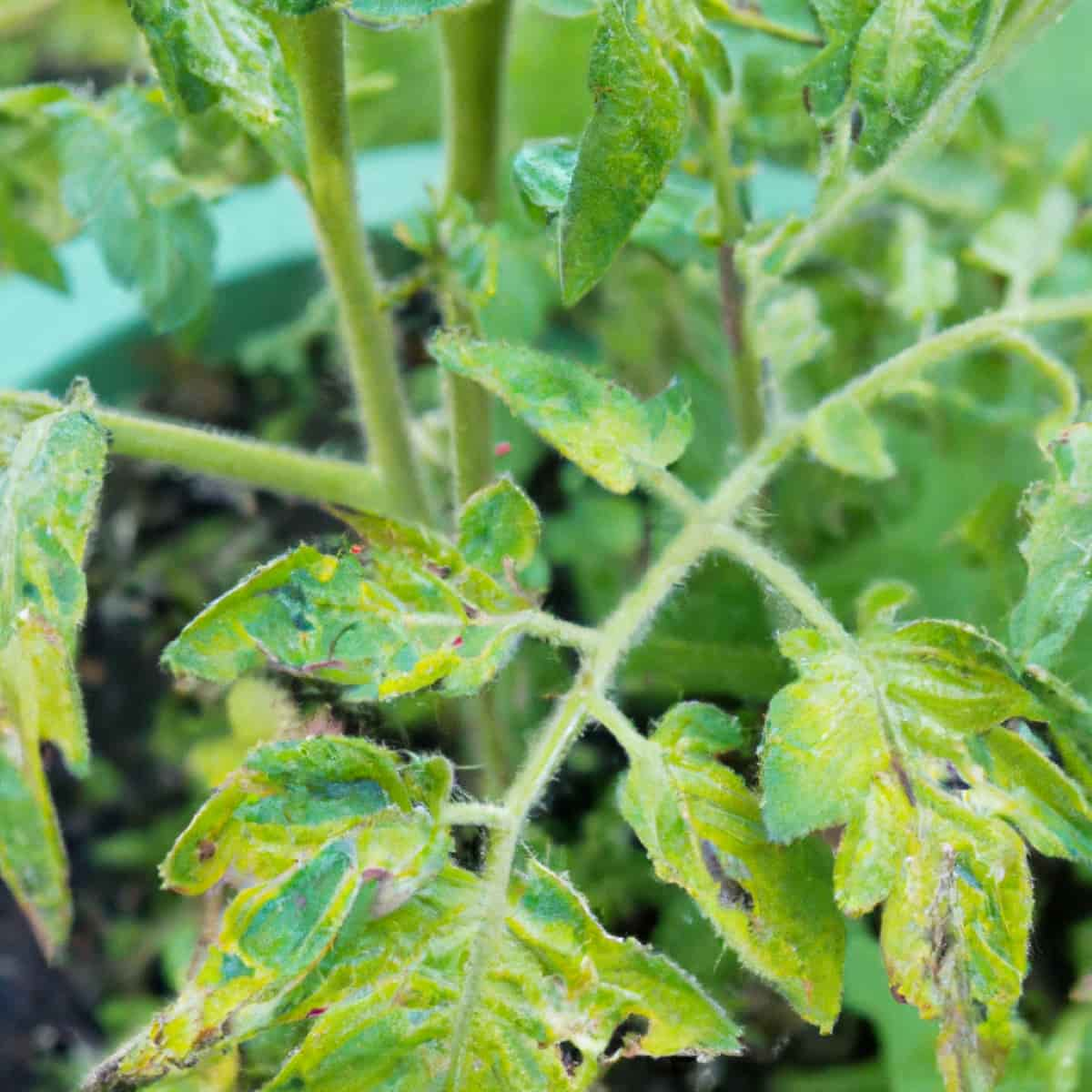Tomatoes are a delicious and versatile ingredient that can be used in countless dishes. Early blight is a common fungal disease that affects Tomato plants, caused by the fungus Alternaria solani. The fungus usually attacks the plant’s lower leaves first before spreading upwards.

Early Blight Symptoms and Control Methods in Tomato Plants
Early Blight Symptoms on Tomato Leaves
The most common symptom of early blight on Tomato plants is the appearance of dark spots or lesions on the leaves. These spots usually start small but can quickly grow larger as the disease progresses. They may also have a concentric ring pattern around them, which helps differentiate them from other types of leaf damage. As early blight spreads, affected leaves may turn yellow and wilt, eventually falling off the plant altogether.
In severe cases, entire branches or plants may become infected and die. It’s important to note that not all leaf damage on Tomato plants is caused by early blight. Other factors, such as insect infestations or nutrient deficiencies, can cause similar symptoms. However, if you suspect your Tomatoes are suffering from early blight, it’s essential to take action to prevent further spread of the disease.
Tomato Plant Early Blight Control Techniques
- Early blight can be a devastating disease for Tomato plants, causing significant damage to leaves and fruit if left untreated. Remove diseased plant material as soon as it’s detected, and dispose of it away from your garden area. This help to prevent the spread of spores that cause early blight disease.
- Another strategy is to provide good airflow around your plants. This means spacing them out adequately and pruning off lower branches to promote better circulation. You could also consider staking or caging your Tomatoes to keep them upright and reduce contact with soil-borne pathogens.
- Applying fungicides at regular intervals can also be an effective way to control early blight in Tomato plants. Opt for products containing chlorothalonil or copper; both are approved for use on edible crops when applied according to directions.
How to Identify Early Blight in Tomato Plants?
- Early blight is a common fungal disease that affects Tomato plants. The initial signs of early blight appear on older plant leaves as small, brown spots with concentric rings that eventually merge into larger lesions.
- The infected leaves gradually turn yellow and drop off, leaving only stems and green fruit behind. Sometimes these spots will have a “target-like” appearance with a series of dark circles around its center. It can spread to other plant parts, causing stunted growth and reduced yield.
- Early identification is critical to prevent further damage. Check the lower leaves for brown or black circular spots about 1/2 inch in diameter with distinctive concentric rings around them.
- If you notice any marks on your Tomato plants, remove those affected areas immediately using pruning shears or scissors. Do not touch healthy foliage after removing diseased sections without washing your hands or gloves. Always dispose of removed foliage away from your garden bed.
Natural Remedies for Early Blight in Tomatoes
- One effective method is to use neem oil, which has antifungal properties that can inhibit the growth of early blight on Tomato plants. Mix neem oil with water according to the instructions on the label and spray it directly onto your Tomato plants.
- Another natural remedy for early blight is baking soda. This simple kitchen ingredient can be mixed with water and sprayed onto Tomato leaves to help prevent fungal growth.
- Garlic also has antifungal properties that make it an effective natural remedy for early blight in Tomatoes. Crush garlic cloves and mix them with water before spraying them on your affected Tomato plants.
- In addition to these remedies, compost tea and chamomile tea have been found to reduce the incidence of early blight in Tomatoes by providing beneficial microorganisms that strengthen plant immunity.
- Natural remedies like these can help keep your garden free from harmful chemicals while effectively controlling early blight in your precious Tomato crops.
In case you missed it: Greenhouse Tomato Plant Diseases: Treatment, Prevention, Management, and Organic Solutions

Preventing Early Blight in Tomato Crops
One way to prevent early blight is by planting resistant cultivars. Another way to prevent early blight is properly spacing out your Tomato plants. Crowded plants can lead to poor airflow and increased humidity, ideal conditions for the disease to thrive. It’s important to keep your garden clean too. Remove any infected leaves or debris immediately, as they can harbor the spores that cause early blight. And always wash your hands and tools after handling infected plants.
Early Blight Resistant Tomato Varieties
One such variety is ‘Mountain Magic,’ which boasts strong resistance to early and late blight. Another option is ‘Celebrity,’ a popular hybrid that offers solid protection against early blight. For those who prefer cherry Tomatoes, the ‘Juliet’ cultivar is an excellent choice with high resistance to the disease. The ‘Rutgers’ variety has been known to hold up well against early blight.
Fungicides for Controlling Early Blight in Tomatoes
- Fungicides are a popular choice for controlling early blight in Tomato plants. They contain chemicals that kill or prevent the growth of fungi, including the ones responsible for early blight. While fungicides can effectively control this disease, using them correctly and safely is important to avoid harming yourself and the environment.
- Several fungicides are available for controlling early blight in Tomatoes, including copper-based products like Bordeaux mixture and other chemical formulations like chlorothalonil. These should be applied according to label directions and regularly to ensure effectiveness.
- Always use protective equipment like gloves and a mask when using any pesticide or fungicide. And remember to follow all instructions carefully regarding application rates, timing, frequency, and disposal of leftover materials.
Integrated Pest Management for Early Blight in Tomato Plants
- Integrated Pest Management (IPM) is an effective way of managing early blight in Tomato plants. This approach involves a combination of cultural practices, biological control agents, and chemical controls to manage the disease.
- One common method used in IPM for early blight management is crop rotation. Tomato plants should not be grown in the same area for at least two years after harvest to reduce the incidence of early blight infection. Proper sanitation practices are also essential in preventing contamination from diseased plant debris.
- Another technique is timely planting. Early planting can help avoid high humidity periods when foliage remains wet for longer, which favors the development and spread of fungal spores responsible for early blight infection.
- Biological control agents such as Bacillus subtilis can be used effectively against early blight infections by suppressing pathogen growth on leaves. Additionally, fungicides that contain copper or sulfur may provide good protection against foliar diseases like early blight while minimizing environmental impact.
Cultural Practices to Reduce Early Blight Incidence in Tomatoes
- Crop rotation is crucial to break up disease cycles. Avoid planting Tomatoes or other Solanaceous crops (such as peppers or eggplants) in the same spot for at least three years.
- Proper spacing between plants allows for better air circulation and reduces humidity levels contributing to fungal growth. Aim for at least two feet between each plant and remove any suckers or foliage that blocks airflow.
- Watering your Tomato plants carefully can help prevent early blight. Watering from below instead of overhead can reduce leaf moisture, which can harbor fungal spores. Also, avoid overwatering and only water when necessary to keep the soil moist.
- Maintaining good hygiene practices while gardening is important too. Always use clean tools when pruning or harvesting Tomatoes, and consider using a fungicide such as copper-based sprays if you live in an area with high disease pressure.
In case you missed it: Hydroponic Tomato Farming in a Greenhouse: Key Rules to Start from Scratch

Conclusion
Early blight is a common fungal disease that affects Tomato plants. It usually starts with the plant’s lower leaves and can spread rapidly if left unchecked. Identifying early blight symptoms in your Tomato plants is essential to controlling its spread.
- Feed Your Flock for Less: Top 10 Tips to Save on Chicken Feed
- Ultimate Guide to Ossabaw Island Hog: Breeding, Raising, Diet, and Care
- Hatching Answers: The Top 10 Reasons Your Chickens Aren’t Laying Eggs
- Eggs and Economics: Breaking Down the Cost of Raising Backyard Chickens
- Defend Your Greens: Proven Methods to Keep Iguanas Out of Your Garden
- Ultimate Guide to Cinnamon Queen Chicken: A Comprehensive Guide for Beginners
- Ultimate Guide to California Tan Chicken: Breeding, Raising, Diet, Egg-Production and Care
- Ultimate Guide to Marsh Daisy Chicken: Breeding, Raising, Diet, and Care
- 10 Types of Chicken Farming Businesses You Can Start for Profits